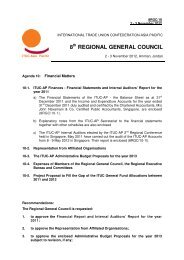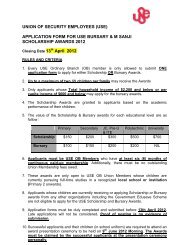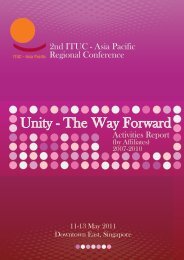BANGLADESH LABOUR LAW: - People Tree Foundation
BANGLADESH LABOUR LAW: - People Tree Foundation
BANGLADESH LABOUR LAW: - People Tree Foundation
Create successful ePaper yourself
Turn your PDF publications into a flip-book with our unique Google optimized e-Paper software.
Introduction<br />
This study builds on the current campaign for labour law reform being waged by the trade unions<br />
in Bangladesh. In brief, the study seeks to flesh out the objective and substantive basis for the<br />
reform movement and the needed reform measures to build a just labour relations system in<br />
Bangladesh in the context of the ILO’s Decent Work Agenda (DWA) and the country’s<br />
commitments to the UN’s Millenium Development Goals (MDGs). As defined by the ILO,<br />
decent work is work obtained in conditions of freedom, equality, security and dignity; on the<br />
other hand, the MDGs seek to reduce poverty by half by 2015.<br />
The overall objective of this study then is to propose reform in the labour law for the promotion<br />
of decent work, reducing poverty and ensuring workers’ protection.<br />
Decent work and mass poverty<br />
Bangladesh has integrated the promotion of decent work as part of the “strategic blocks” under<br />
its “Poverty Reduction Strategy Papers” (PRSP). Updated periodically, the PRSP outlines the<br />
broad socio-economic development programs being pursued by the country to meet its MDG<br />
commitments.<br />
As it is, mass poverty has remained the single most critical development-retarding problem in<br />
Bangladesh. The country has reduced poverty by only one percentage point per year during the<br />
1990s. This has allowed a vast and growing number of people to remain unemployed and<br />
underemployed. There are presently over 63 million people below the poverty line, one-third of<br />
whom are trapped in extreme poverty.<br />
The slow pace of MDG fulfilment by Bangladesh is due partly to the pursuit of a narrow growth<br />
only economic strategy, which has, over the years, produced an unequal and even job-less<br />
growth pattern. It has also resulted in a mismatch between sectoral growth and overall labour<br />
absorption in the country (Titumir and Hossain 2005).<br />
For instance, while the contribution of the industrial sector in the GDP has jumped from 29.73<br />
per cent in 2008-09 to 17.31 per cent in 1980-81, nearly 80 per cent of the country’s employed<br />
are still in the huge informal economy where labour standards are hardly observed 1 .<br />
Additionally, the situation in the formal manufacturing sector is far from sanguine. Reports of<br />
worker and human rights violations within and around the different factories are widespread. The<br />
repression of these rights has in fact led to numerous factory protests and blockades in recent<br />
years. Most of the workers in the private manufacturing sector also do not get the various non-<br />
1 However, there is an increasing participation of women in the labour market, growing at a rate of<br />
5.45 per cent annually versus 1.23 per cent for men for the period 2003–06 (although the women<br />
workers account only for one-fourth [12.1 million] of the total labour force of 49.5 million).<br />
2
















